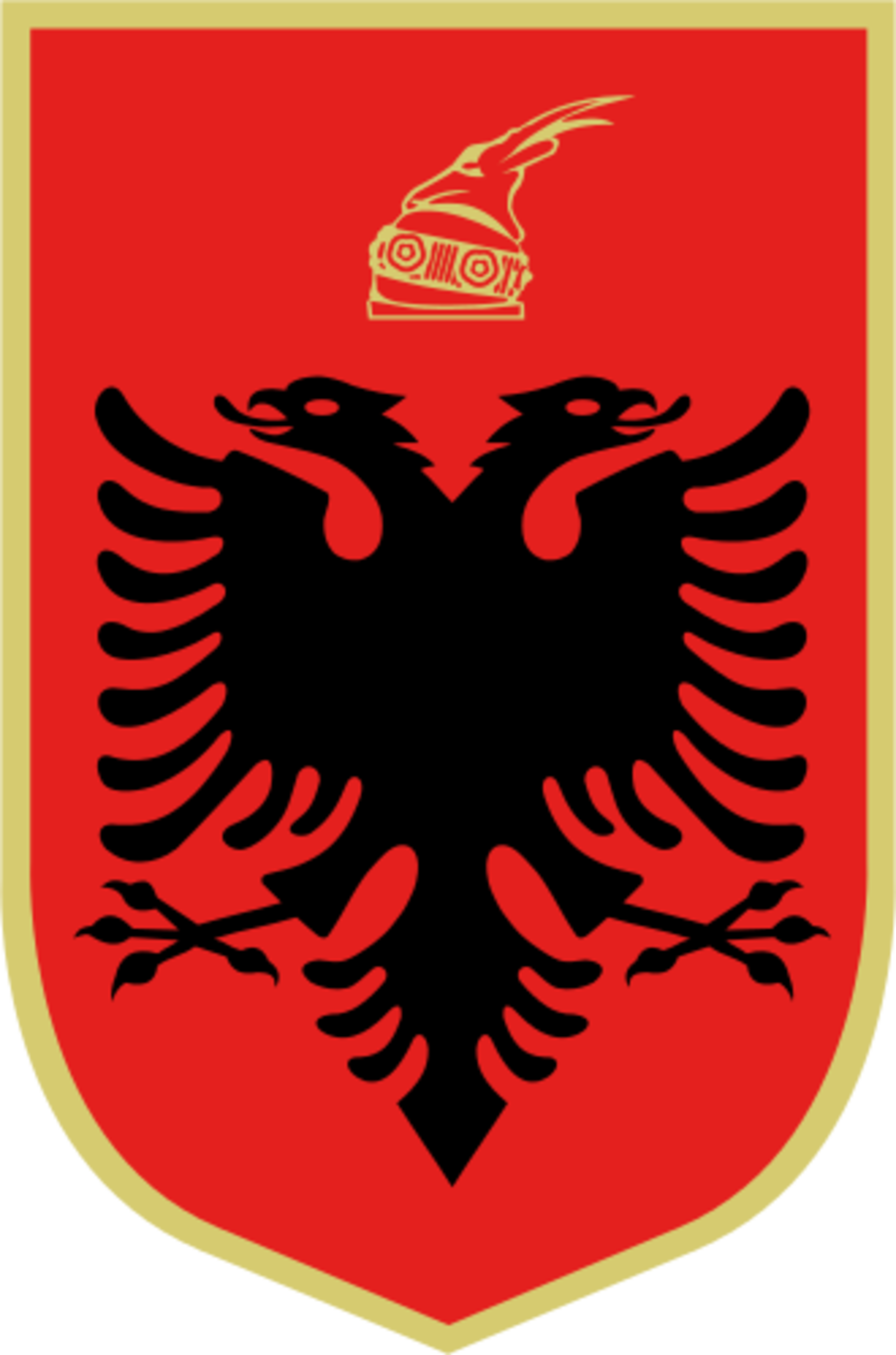Albania
After the collapse of the Kingdom of Yugoslavia (1941), Albania gained a territorial extension which included parts of Kosovo, Macedonia, Greece and Montenegro. Even the development of a “Greater Albania” under fascist auspices during the war cannot be taken as a serious manifestation of Albanian official policy. It was largely an Italian enterprise designed to win over mass support.

Coat of arms
Shirt
| Position | First name | Last name | Mjesto rođenja | Like | Dislike |
|---|
(Today: Albania, parts of Kosovo, Montenegro and Greece)
The plan of making of the Great Albania is as old as Albanian nationalism, which, from its beginnings in the second half of the 19th century, had two centers - in Tirana and in Pristina.[1] Like all other European national ideologists (Serbian, Croatian, Bulgarian, Greek, etc.), Albanians also had to invent their own national myths and create artificial continuity with the distant past in order to justify their demands for the creation of nation and national state. Although Byzantine sources from the 11th century had been used term Albanon (lat. Albanum) for the areas northeast of the adriatic Durrës and west of Ohrid, [2] there had never existed a medieval Albanian state. Therefore, Albanian ideologists pointed to their roots of the ancient Illyrians' kingdom as a sort of Albanian ancestor. Like their European counterparts, they also extracted some famous medieval personalities from the context of their time and proclaimed them "Albanian" national heroes (eg Skenderbeg) [3] Albanian nation was constructed during 19th and 20th from population which lived for centuries without any standardized Albanian language, without any idea of communion, and was divided into three faiths and two main tribal groups (Gheg and Tosk). [4]And all within the five centuries of Ottoman rule had traditionally tried to preserve adherence to Islam and pursued a divide and rule policy, openly encouraging divisions between Moslems, Catholics and Orthodox Christians. [5]
During the Balkan Wars (1912-1913), Albanians managed to get their state with Tirana as capital. However, Kosovo with Pristina was then given to the kingdom of Serbia, [6] which, in its own interpretations of the past, laid down its ethnic and historical rights to it,. Moreover, the myths about Kosovo's battle (1389) were at the center of the design of Serbian national identity. The Albanian state has been consistently weak since its inception in 1913 and, especially in the interwar period, more concerned about defense against hostile neighbors and maintaining existing frontiers than with the quest for national unification.[7] Separated long before any serious work was done in creating a single identity, Albanians in Albania and Kosovo largely went their separate ways. Since Italy, Greece and Yugoslavia in the interwar period were making claims that would have left Albanians with little more than a triangle linking Tirana, Durres and Vlora, Albanian leaders opted for policies that would preserve the existence of Albania within existing borders. Any adventurous pursuit of incorporating Kosovo could only invite disaster for Albania.[8]
Despite the fact that Albania was already under Italian protection, ie de facto its protectorate, Italy decided to occupy it in 1939. [9] During the Second World War, however, she obtained the earlier mentioned territorial expansion in the areas with Albanian populations, including Kosovo.
During the WW II, the question of Kosovo became a major bone of contention between Albania’s potential liberators. The nationalist Balli Kombetar (National Front) formed in 1942 by Midhat Frasheri, called for the creation of a greater Albania while the Communist-dominated National Liberation Movement owed much of its existence to crucial assistance from Yugoslavia’s Communists. So Hoxha was eager to ensure that territorial expansion did not undermine the solidarity between Yugoslav and Albanian Communists as Yugoslav support took precedence over other concerns. Significantly, the wartime division between Communists and nationalists was largely a reflection of the old Geg-Tosk split as the Albanian Communist movement was very much a southern phenomenon.[10]
- [1] Robert C. Austin, Greater Albania: The Albanian State and the Question of Kosovo, 1912–2001. In: John Lampe et Mark Mazower, IDEOLOGIES AND NATIONAL IDENTITIES:The Case of Twentieth-Century Southeastern Europe, https://books.openedition.org/ceup/2434
- [2] ''Albanija'', http://www.enciklopedija.hr/Natuknica.aspx?ID=1368
- [3] Stephanie Schwandner-Sievers, Bernd Jürgen Fischer, Albanian Identities: Myth and History, Indianapolis: Indiana University press 2002, 43, 75
- [4] Igor DESPOT, Tisak Hrvatske i Dalmacije o balkanskim ratovima (1912-1913) ,Historijski zbornik, ,62/2001.,br.1, 116
- [5] Robert C. Austin, Greater Albania: The Albanian State and the Question of Kosovo, 1912–2001. In: John Lampe et Mark Mazower, IDEOLOGIES AND NATIONAL IDENTITIES:The Case of Twentieth-Century Southeastern Europe, https://books.openedition.org/ceup/2434
- [6] Felipe FERNANDEZ-ARMESTO, Narodi Europe, Zagreb, 1997.,216
- [7] Robert C. Austin, Greater Albania: The Albanian State and the Question of Kosovo, 1912–2001. In: John Lampe et Mark Mazower, IDEOLOGIES AND NATIONAL IDENTITIES:The Case of Twentieth-Century Southeastern Europe, https://books.openedition.org/ceup/2434
- [8] Robert C. Austin, Greater Albania: The Albanian State and the Question of Kosovo, 1912–2001. In: John Lampe et Mark Mazower, IDEOLOGIES AND NATIONAL IDENTITIES:The Case of Twentieth-Century Southeastern Europe, https://books.openedition.org/ceup/2434
- [9]''Albanina Kingdom'', https://en.wikipedia.org/wiki/Albanian_Kingdom_(1939%E2%80%9343)
- [10] Robert C. Austin, Greater Albania: The Albanian State and the Question of Kosovo, 1912–2001. In: John Lampe et Mark Mazower, IDEOLOGIES AND NATIONAL IDENTITIES:The Case of Twentieth-Century Southeastern Europe, https://books.openedition.org/ceup/2434
Sources
- Robert C. Austin, Greater Albania: The Albanian State and the Question of Kosovo, 1912–2001. In: John Lampe et Mark Mazower, IDEOLOGIES AND NATIONAL IDENTITIES:The Case of Twentieth-Century Southeastern Europe, https://books.openedition.org/ceup/2434
- Igor DESPOT, Tisak Hrvatske i Dalmacije o balkanskim ratovima (1912-1913), Historijski zbornik, ,62/2001.,br.1.
- FERNANDEZ-ARMESTO, Narodi Europe, Zagreb, 1997.
- Stephanie Schwandner-Sievers, Bernd Jürgen Fischer, Albanian Identities: Myth and History, Indianapolis: Indiana University press 2002.
- ''Albanija'', http://www.enciklopedija.hr/Natuknica.aspx?ID=1368
- ''Albanina Kingdom'', https://en.wikipedia.org/wiki/Albanian_Kingdom_(1939%E2%80%9343)
